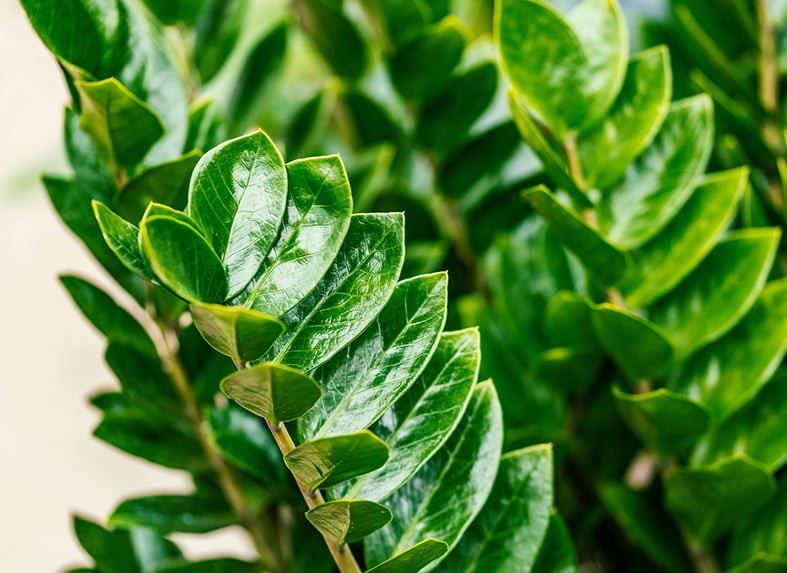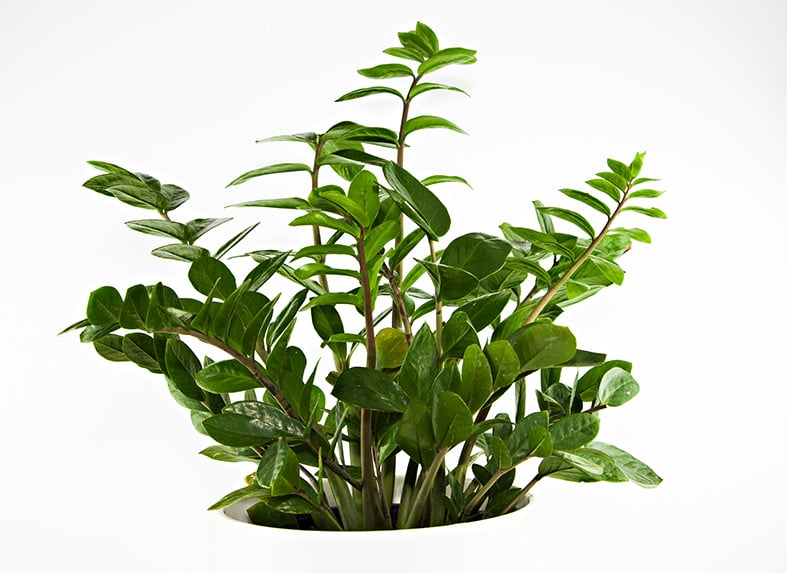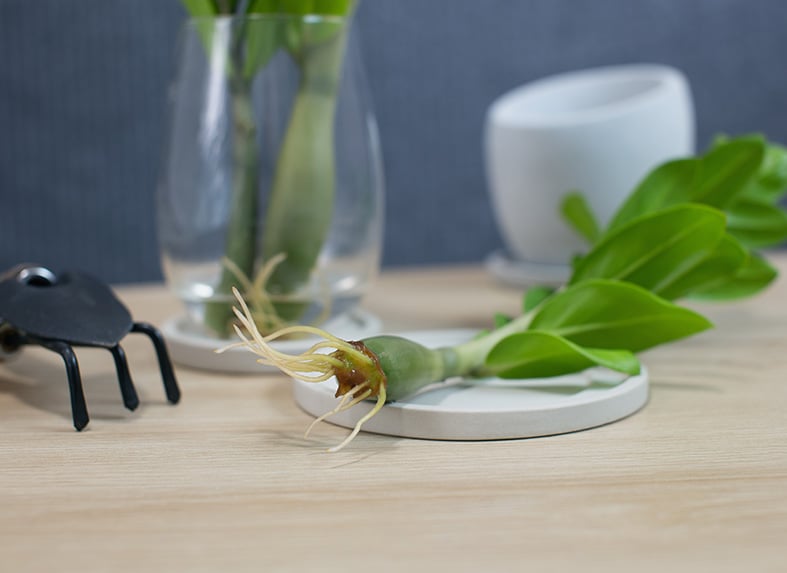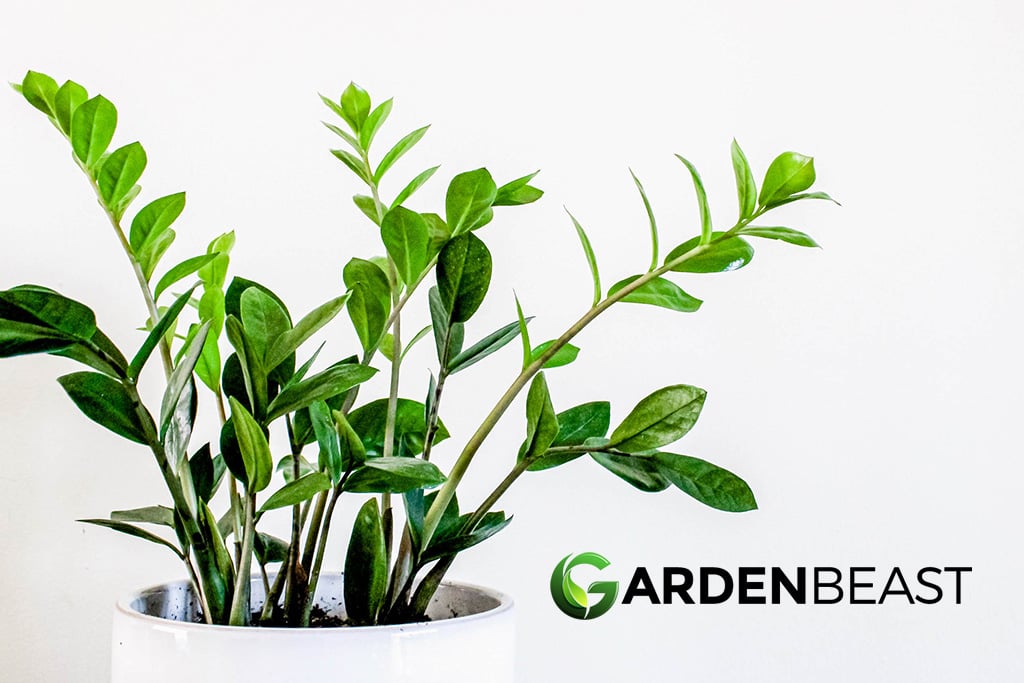Zamioculcas zamiifolia, commonly known as Zanzibar Gem, ZZ Plant, Eternity Plant, or Emerald Palm, is the only species of flowering plants from the Zamioculcas genus in the Araceae family. Zamioculcas plants are perennials that can be found in the tropical regions of eastern Africa, from north-eastern South Africa to southern Kenya.
These plants were first named Caladium Zamiifolium in 1829, then moved to the current genus by the Austrian botanist Heinrich Wilhelm Schott in 1856. Their botanical name, Zamioculcas, was given by Adolf Engler in 1905, which derives firstly, from the slight similarity of its foliage to that of the plants from the Zamia genus and secondly, its kinship to the Colocasia genus.
ZZ plants are very popular ornamental houseplants, as they can be grown both indoors and outdoors. They are very easy to grow and pretty forgiving if you do not have time for them, making them the perfect choice for any beginner gardener.
Watch Our Latest YouTube Video ...
About ZZ Plants
- These plants will survive even in the lowest light conditions. However, they prefer moderate and indirect light. For uniform growth on all sides, it is best to rotate your ZZ plant once in a while.
- Zamioculcas plants are tolerant of drought periods. Due to their succulent roots, they can retain an impressive amount of water, so you do not need to water them frequently. Allow the soil to dry out completely before the next watering.
- If you are a busy person, you can purchase a self-watering container that will take care of your ZZ plant for you.
- During their growing season, from spring to fall, your ZZ plant may benefit from a fertilizer once every month. The ideal fertilizer for them is an organic liquid houseplant one.
- When repotting your Zamioculcas plant, make sure you do not choose a potting container that is much larger than the current one, as this may result in root rot.
- Give these plants a little extra attention, cleaning their leaves of dust with a soft cloth. During this process, you can also check your plant for pests.
- They are considered good air purifiers, as they have the ability to remove large amounts of toxins such as benzene, toluene, and xylene from the air.
- ZZ plants are pretty toxic, so you should keep them away from curious pets and children. It’s recommended to use gloves when you need to repot them or prune them, but if you happen to touch them, make sure to wash your hands afterward to avoid skin irritation.

ZZ Plants Features: An Overview
- ZZ plants can grow pretty big and they can even look like trees or palms. This is the reason why they are also known as Aroid Palms or Emerald Palms. Other botanical synonyms for these plants include Zamioculcas Loddigesii, Caladium Zamiaefolium, and Zamioculcas Lanceolata.
- They are herbaceous plants that grow between 17 and 23 inches (45-60 cm) tall from a succulent, potato-like rhizome. Generally, they are evergreen plants, but they can become deciduous in drought conditions.
- ZZ plants have pinnate, 15.7-23.6 inches (40-60 cm) long leaves with 6-8 pairs of 2.8 to 5.9 inches (7-15 cm) long leaflets. Their waxy, smooth, glossy, and dark green leaves grow on stems that are thickened at the bottom.
- Their leaves’ lifespan is estimated to at least six months and their roots can store a high amount of water. As a result, Zanzibar Gem plants can survive for four months without bright light and water.
- From the midsummer to the beginning of the autumn, these plants produce flowers that are mostly hidden among the leaf base. They can grow up to 2.8 inches (7 cm) long in a small, yellow-brown spadix. ZZ plants bloom only in their native habitat or if they are grown outdoors.
- They have a few usages in traditional medicine such as treatments for earache, inflammatory conditions, ulceration, and stomach ache.

Growing ZZ Plants
ZZ plants are low-maintenance and slow-growing tropical semi-succulents. These plants do not require too much care, as they can thrive in almost any environmental condition. They are a suitable choice for owners that occasionally neglect or forget about them.
These plants love bright and indirect light, but they can also grow just fine when they are placed in rooms or spots with low levels of light. However, when Zamioculcas plants experience long periods of shade, their growth rate will be slowed down significantly.
They will have a great time in warm conditions that are also comfortable for humans. The ideal temperatures for them to grow healthy are those between 60 and 75 °F (15-24 °C). These plants are quite sensitive to extreme temperatures, so you should keep them indoors during winter or when the temperatures drop below 45 °F (8 °C).
When it comes to potting soil, ZZ plants have no special demands. They will benefit from any well-draining potting mix you provide them with. To improve the drainage system, you can look for a mix that contains a large amount of sand or perlite, such as a cactus or succulent soil mix. Also, make sure you grow your plant in a container with drainage holes.

During their growing season, from April to August, dilute an all-purpose, organic liquid fertilizer according to the package instructions and feed it to your plant once a month. Some retailers use an organic potting soil combined with a slow-release fertilizer, so you might not need to feed your plant for the first six months.
If the time to repot your ZZ plant has come, it’s best to choose a slightly larger container. For small plants, you need to choose a pot that is 1-2 inches (2-5 cm) larger than the current one. When your plant is bigger, a container that is 2-4 inches (5-10 cm) larger is more than enough. This process should be done every 18-24 months in the spring or summer.
Regular pruning may be necessary, as it can keep your plant fresh-looking. The leaflets that start to turn yellow can be cut close to the base of their stem. You can also remove the stems that have grown much longer than the other ones.
- SYLISH ELEGANCE: The ZZ plant is a stunning addition to any home or office décor. The houseplant has glossy, dark green leaves, creating a bold and sophisticated look. ZZ plant's upright growth and architectural shape bring a focal point to any space
- GORGEOUS HOME DECOR: ZZ plant adds flair to any interior space. Its versatility in any setting make it a beautiful companion to place on a tabletop, desk, shelf, or as a floor plant. ZZ is potted in a nursery pot, ready to admire instantly after unboxing
- PROMOTES WELLNESS: Plants make us happy. They give us life, fresh air and a sense of calm - all of which have the ability to lift your mood and improve your wellbeing. NASA studies show having plants improves mood, creativity and reduces stress
- UNIQUE GIFT: Surprise your loved ones with a live ZZ plant, ready to be gifted for any occasion, including birthday, anniversary, and housewarming. It's a refreshing alternative to flowers or typical gifts, creating a lasting memory that shows you care
- EASY CARE: The ZZ plant is an excellent choice for both new plant parents or experienced owners. Its light and watering requirements make it easy to appreciate the hassle-free nature and beauty of ZZ without the stress of a complicated plant care routine
- LIVE INDOOR PLANT: Bring home a beautiful easy-to-grow ZZ plant for a tropical feel. This houseplant has shiny, dark leaves, adding flair to any space. ZZ improves room aesthetic, bringing a focal point to any living room, office, or bedroom decor
- GORGEOUS HOME DECOR: The small size of striking ZZ plant fits well on tabletops, desks, windowsills, plant shelves, and even patios. ZZ comes wonderfully potted in a modern decor planter, ready to be enjoyed and admired instantly after unboxing
- ELEVATE MOOD & WELLBEING: Plants make us happy. They give us life, fresh air and a sense of calm - all of which have the ability to lift your mood and improve your wellbeing. NASA studies show having plants improves mood, creativity and reduces stress
- HAPPY & HEALTHY PLANT: Your new live indoor plant arrives well-packed with care instructions. Keep your ZZ happy, healthy, and growing by placing it in bright, indirect sunlight. Water with approximately 1 cup of water about once a week. Adjust as needed
- PLANTS MAKE GREAT GIFTS: Plants can be delivered to your loved ones for any occasion, including birthdays, anniversary, and housewarming. Enjoy peace of mind that every plant is well packaged, farm fresh, and ready to impress with your gift message
- Rare ZZ Plant - Zamioculcas zamiifolia - Easy to Grow House Plant - 4" Pot
- 810061369318
- Proper name: Zamioculcas zamiifolia
- Hirt's Gardens
- Garden & Patio
Last update on 2024-09-27 / Affiliate links / Images from Amazon Product Advertising API
Watering ZZ Plants
ZZ plants are semi-succulents that have the ability to store water in their roots, so they are pretty drought tolerant. Depending on the region you live in and the conditions in which you grow your ZZ plants, the frequency of watering may differ.
Usually, it’s recommended to use the ‘soak and dry technique’ which means allowing the potting soil to dry out completely before you water the plant again. It is always better to under-water Zanzibar Gem plants than to over-water them because too much water may cause their rhizome to rot.
Make sure you do not water your plant too often, as this can result in yellow leaves and brown stalks. Moreover, if the leaves start to drop, it could also be a sign that the plant is over-watered. In this case, you should start pruning your plant and skip watering for about a month.
If you notice that the leaves have dry and crispy tips, you need to prune your ZZ plant and increase the frequency of watering, as this is a common indicator of under-watering. They prefer the average levels of house humidity. You can maintain the ideal levels of humidity by misting the leaves or using a humidifier.
Propagating ZZ Plants
Zamioculcas plants grow faster when more or larger rhizomes are grown together. The most common methods to propagate Zamioculcas plants are by dividing rhizomes or using leaf cuttings.
If you want to propagate your Zanzibar Gem plant by division, you need to separate the plant’s roots. Gently remove the mother plant from its potting vessel and remove the excess soil from the chosen root.

Search for natural points of division and saw through the root and rhizomes using a utility knife. Once you have your potato-shaped root, you can plant it into a new container filled with potting soil. Water the plant until the soil is damp and give it the usual care.
The easiest way to propagate your plant is by collecting any healthy leaves that have fallen from the mother plant and then plant them into the same soil. However, if there are no such leaves, you can take a leaf cutting using a clean and sharp knife. Remove the leaflets that grow on the first 6-8 inches (15-20 cm) of the stem, as they can be propagated as well. Put the leaf into a glass of water or in a pot with damp soil.
Depending on the environmental conditions from your home, you should notice new rhizomes growing after several months.
In Conclusion
ZZ plants are the missing piece from every kitchen, desk, or office. They spruce up any space and they don’t demand a lot of your attention. These versatile houseplants can remain in perfect shape even when you forget about their existence.
Zamioculcas plants will feel like home in bright and indirect light, warm and pretty humid environment, with watering from time to time, well-draining organic potting soil mix, and regular pruning. If you cannot provide them with proper sunlight or watering, don’t worry! They will put their survival skills to work and start to take care of themselves.



